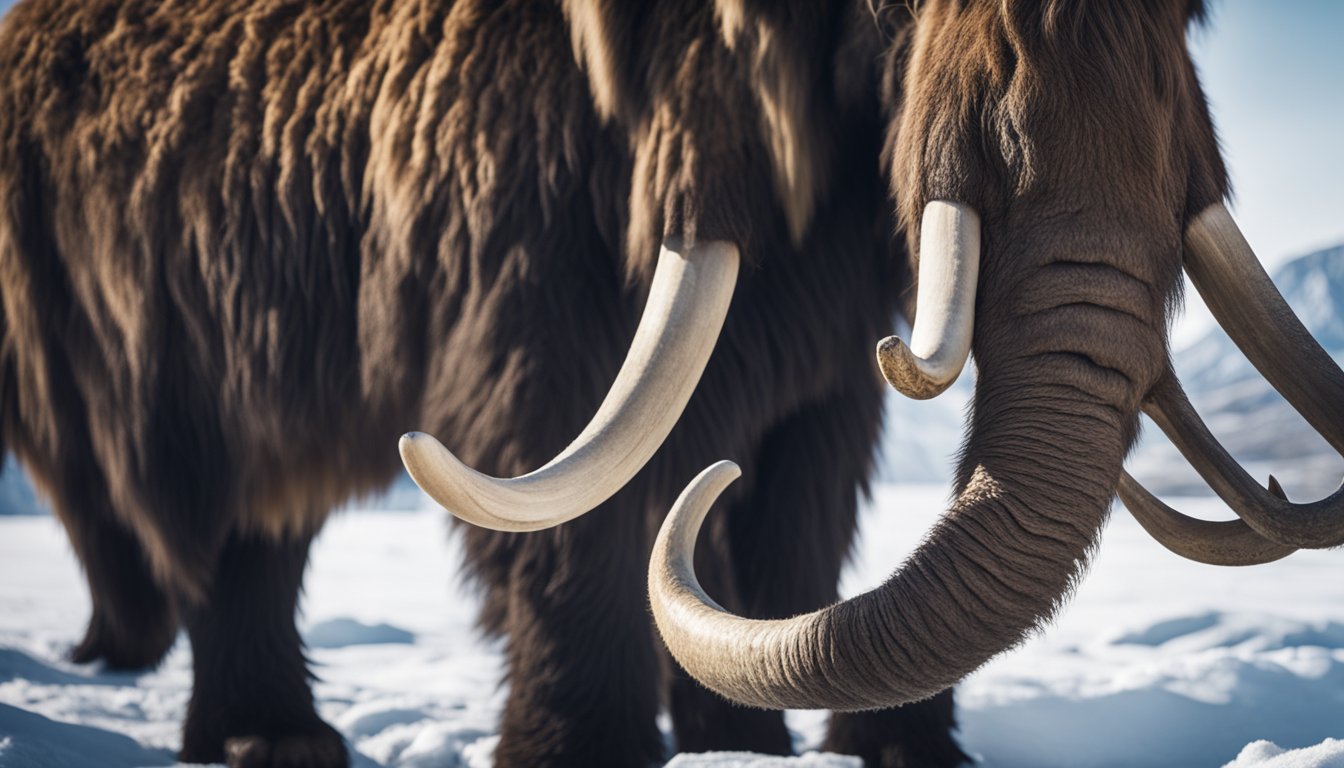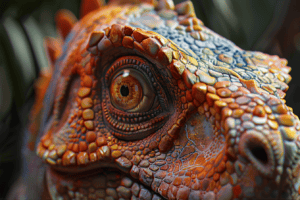The woolly mammoth is one of the most fascinating creatures to have ever lived on Earth.
This massive elephant-like animal roamed the planet during the Ice Age, which lasted from about 2.6 million to 11,700 years ago.
It was well adapted to the cold climate, with a thick fur coat and long, curved tusks that could grow up to 15 feet in length.
Unfortunately, the woolly mammoth went extinct at the end of the Ice Age, but scientists are now working to bring this magnificent creature back to life.

Through the use of cutting-edge technology, scientists are attempting to clone the woolly mammoth using DNA samples that have been extracted from well-preserved specimens found in the permafrost of Siberia.
The process involves replacing the nucleus of an elephant egg with the nucleus of a woolly mammoth cell, creating a hybrid embryo that can be implanted into an elephant surrogate.
While this process is still in its early stages, it holds the promise of bringing the woolly mammoth back from extinction and reintroducing it to the wild.
Despite the controversy surrounding the ethics of cloning extinct species, the potential benefits of bringing back the woolly mammoth are numerous.
For one, it could help to restore balance to ecosystems that have been disrupted by human activity.
The woolly mammoth was a keystone species during the Ice Age, playing a crucial role in maintaining the health and diversity of its habitat.
Additionally, studying the woolly mammoth could provide valuable insights into the biology and behavior of this fascinating creature, shedding new light on the history of life on Earth.
Unveiling the Woolly Mammoth
The woolly mammoth, an Ice Age giant, is a fascinating creature that has captured the imagination of scientists and the public alike.
In this section, we’ll explore the physical characteristics, habitat, and range of this magnificent animal.
Physical Characteristics
The woolly mammoth was a massive creature, standing up to 11 feet tall at the shoulder and weighing as much as 6 tons.
Its long, curved tusks could grow up to 16 feet long and were used for defense, digging up roots, and fighting other mammoths.
The woolly mammoth’s ears were small and rounded, and its fur was long and shaggy, providing insulation against the cold.
Habitat and Range
The woolly mammoth lived in the cold, grassy plains of the northern hemisphere, including Europe, Asia, and North America.
During the last Ice Age, the mammoth’s range extended as far south as Mexico and as far north as the Arctic Circle.
The woolly mammoth’s habitat was characterized by cold temperatures, permafrost, and a lack of trees.
Despite its impressive size and strength, the woolly mammoth eventually went extinct around 4,000 years ago.
However, recent advances in biotechnology have raised the possibility of bringing the woolly mammoth back to life through a process known as de-extinction.
While this process is still in its early stages, it has the potential to unlock new insights into the woolly mammoth’s biology and behavior, as well as the broader field of evolutionary biology.
Life During the Pleistocene

The Pleistocene epoch, also known as the Ice Age, was a time when the Earth was much colder than it is today.
During this time, many animals roamed the planet that are now extinct. One of the most famous of these animals is the Woolly Mammoth.
Diet and Behavior
Woolly Mammoths were herbivores, meaning they only ate plants.
They had long, curved tusks and large, flat teeth that were perfect for grinding up tough grasses.
They also had a special type of tooth called a “molariform,” which helped them to chew their food more efficiently.
Mammoths were social animals and lived in herds.
They were very protective of their young and would often work together to defend them from predators.
Despite their large size, they were actually quite agile and could run at speeds of up to 20 miles per hour.
Mammoth Steppe Ecosystem
During the Pleistocene epoch, much of the Earth’s surface was covered in a habitat known as the Mammoth Steppe.
This was a vast grassland that stretched from Europe to North America. It was home to many different types of animals, including the Woolly Mammoth.
The Mammoth Steppe was an important ecosystem because it helped to regulate the Earth’s climate.
The grasses that grew there absorbed carbon dioxide from the atmosphere, which helped to reduce the amount of greenhouse gases in the air.
The Woolly Mammoth played an important role in this ecosystem because it helped to keep the grasses trimmed and healthy.
In conclusion, the Woolly Mammoth was an important part of the Pleistocene epoch.
It was a herbivore that lived in herds and had special teeth for grinding up tough grasses.
It also played an important role in the Mammoth Steppe ecosystem by helping to keep the grasses healthy.
The Mystery of Extinction

The Woolly Mammoth, a massive Ice Age giant, once roamed across the vast expanses of the northern hemisphere.
However, they vanished from the face of the Earth around 4,000 years ago, leaving behind a trail of mysteries and unanswered questions.
Climate Change Impact
One of the most popular theories for the extinction of Woolly Mammoths is climate change.
During the last Ice Age, the Earth’s climate was much colder than it is today.
However, as the planet began to warm up, the mammoths’ habitat and food sources began to disappear.
The melting of glaciers and the subsequent rise in sea levels led to the loss of landmasses and the migration of animals.
The changing climate may have been too much for the mammoths to adapt to quickly enough, leading to their eventual extinction.
Human Influence
Another theory is that humans played a significant role in the extinction of Woolly Mammoths.
Radiocarbon dating of mammoth bones and tusks has revealed that humans hunted these creatures for food and used their bones for tools, clothing, and shelter.
The hunting of mammoths by humans may have led to a decline in their population, making them more vulnerable to other factors such as climate change.
While the exact cause of the Woolly Mammoth’s extinction remains a mystery, it is clear that both climate change and human influence played a significant role.
Despite their disappearance, the legacy of these magnificent creatures lives on, and scientists continue to study their remains to uncover more about their lives and the world they once inhabited.
Reviving the Giants

The Woolly Mammoth, an Ice Age giant that roamed the Earth over 4,000 years ago, is coming back to life.
Thanks to the groundbreaking work of Colossal, a biotech company, and Harvard geneticist George Church, the de-extinction of this magnificent beast is now within reach.
De-Extinction Science
The de-extinction of the Woolly Mammoth involves using DNA and genes from well-preserved remains of the extinct species to create an embryo that can be implanted into a surrogate mother.
The process starts by recreating the genes artificially and then placing them into the embryo of an Asian elephant, the closest living relative to the Woolly Mammoth.
The embryo is then implanted into an Asian elephant, which gives birth to the Woolly Mammoth.
The process of de-extinction is still in its early stages, and there are many scientific challenges to overcome.
However, the potential benefits of de-extinction are enormous.
By bringing back extinct species, we can learn more about their biology and ecology, and we can restore lost ecosystems.
Ethical Considerations
While the idea of bringing back extinct species is exciting, it also raises important ethical questions.
Is it right to bring back a species that has been extinct for thousands of years?
What are the risks of introducing a species back into an ecosystem that has evolved without it?
And what about the welfare of the surrogate mothers that carry the embryos?
These ethical considerations are being carefully considered by scientists and policymakers.
It is important to ensure that the benefits of de-extinction outweigh the risks and that any de-extinction projects are carried out in a responsible and ethical manner.
In conclusion, the de-extinction of the Woolly Mammoth is an exciting development in the field of biotechnology.
While there are still many scientific and ethical challenges to overcome, the potential benefits of de-extinction are enormous.
By bringing back extinct species, we can learn more about our planet’s rich history and restore lost ecosystems.
Frequently Asked Questions

How did woolly mammoths adapt to their cold environments?
Woolly mammoths were well adapted to living in cold environments.
They had several physical adaptations that helped them survive in the harsh conditions of the Ice Age.
For example, they had long, shaggy fur that kept them warm, and they had small ears to reduce heat loss.
They also had a layer of fat under their skin to insulate them from the cold.
Their tusks were used to dig through snow and ice to find food, and their large size helped them conserve heat.
What are the theories behind the extinction of woolly mammoths?
There are several theories about why woolly mammoths went extinct. One theory is that they were overhunted by humans.
Another theory is that climate change caused their extinction. During the last Ice Age, the climate was much colder and drier than it is today.
As the climate warmed, the mammoths’ habitat changed, and they may have been unable to adapt.
Disease and competition with other species may have also played a role in their extinction.
How similar were woolly mammoths to today’s elephants?
Woolly mammoths were very similar to today’s elephants.
They were both members of the same family, and they had many of the same physical characteristics.
For example, they both had trunks, tusks, and large ears.
However, woolly mammoths were adapted to living in cold environments, while modern elephants are adapted to living in warm environments.
Woolly mammoths were also larger and had longer, shaggier fur than modern elephants.
What did woolly mammoths typically eat during the Ice Age?
Woolly mammoths were herbivores, which means they only ate plants.
During the Ice Age, their diet consisted mainly of grasses, sedges, and other low-growing plants. They also ate leaves, twigs, and bark from trees and shrubs.
In the winter, they would dig through snow and ice to find lichens and other plants that were buried beneath the surface.
How are scientists trying to bring woolly mammoths back to life?
Scientists are trying to bring woolly mammoths back to life using a process called de-extinction.
This involves using DNA from preserved mammoth specimens to create a genetically modified elephant embryo that has some of the traits of a woolly mammoth.
The embryo would then be implanted into an elephant surrogate mother, who would give birth to the baby mammoth.
While this technology is still in its early stages, scientists believe it could one day be used to help restore lost ecosystems and protect endangered species.
What discoveries have been made about woolly mammoth social behavior?
Scientists have discovered that woolly mammoths were social animals that lived in herds.
They had a complex social structure that was based on age and gender.
For example, older females were the leaders of the herd, while younger females and males were subordinate.
They also had a strong maternal bond, and mothers were very protective of their young.
Scientists have also found evidence of communal care, where several females would work together to care for each other’s young.







